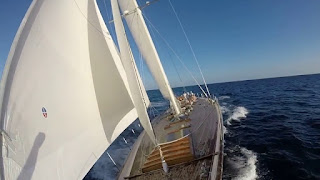A tale of two sails!
it was the most traditional of times and yet the most modern?
Apologies to Charles Dickens for bastardising one of literature’s most iconic
opening lines.
But looking through my order list I was struck at the varied
nature of the sails we had on order! We are currently building sails for
everything from the smallest pram dinghy, trailer sailers, traditional cruising
yachts, Sydney 32 and 38’s right up to canting keel Cookson 50’s. Each sail has
its own nuances and requirements.
Let’s compare two sails-
A full on racing Laminate designed sheerly for speed but with some concessions
for longevity for club/ regatta racing on a Sydney 32.
The other a Dacron Sail being built for “Westwind”, a beautiful classic yacht, indeed the first
yacht ever built by the legendary Jock Muir in Tasmania.
 |
| Zeptyr Membrane |
Firstly, let’s look at a modern Membrane sail, in this case
a sail we are making for a Sydney 32, featuring Zeptyr Sails technology, made
in Sydney Australia and finished in loft by your scribe. Featuring corner to
corner stringing, we have previously made up a dozen or so sails in an earlier
incarnation. And were overwhelmingly happy with so many aspects of them,
particularly their longevity (some sails are still going after 10+ years,
amazing for a membrane)! It is fantastic to see them back on the water with new
features and modernisation.
Creating a modern laminate sail requires an intricate blend
of technology, craftsmanship, and material science. At its core, the process
begins with selecting advanced materials, such as carbon fibre or aramid, known
for their strength and lightweight properties. These fibres are meticulously
arranged in specific orientations to optimize performance, balancing durability
with flexibility.
The next step involves precision lamination, where layers of
film and fabric are bonded using high-tech adhesives and controlled heat. This
ensures a seamless integration, reducing drag while increasing efficiency.
Computer-aided design plays a pivotal role in shaping the sail, allowing for
exact calculations and tailoring to suit the unique demands of each vessel.
What makes a laminate sail truly modern is not just its
construction but its customization. From aerodynamic enhancements to UV
protection, every detail is considered. The result? A sail that embodies speed,
resilience, and innovation, pushing the boundaries of what’s possible on the
water.
The second sail is a Dacron Cream mainsail for “Westwind”,
the first boat that the legendary Jock Muir built in Tasmania, I was admiring
her at my recent venture down to Hobart for the Wooden Boat Festival. Her
current custodian (no one ever owns boats like these) Chris Dicker approached
me by referral to build a new mainsail for her.
While modern laminate sails showcase cutting-edge
technology, traditional Dacron sails tell a story of time-honoured
craftsmanship and enduring utility. The process of making a Dacron sail begins
with selecting the fabric—a polyester material prized for its durability,
affordability, and versatility. Unlike laminates, Dacron sails are constructed
using woven textiles, which provide a robust yet forgiving surface, perfect for
cruising, low level racing and casual sailing.
Once the fabric is chosen, the sailmaker carefully measures
and cuts the panels, traditionally on the sail loft floor, but these days
benefitting from moder CAD/CAM cutting machines. Precision stitching follows,
as each seam is reinforced to withstand the forces of wind and water. Unlike
the heat and adhesives used in laminates, the craftsmanship of Dacron sails
relies entirely on thread and needle, turning the process into a labour of
love.
Customization is equally important in traditional sails.
From reef points to battens, every element is tailored to the sailor’s needs. This
sail will have a two-ply leech for extensive usage (many sea miles ahead) and
reefs will be friction rings in lieu of the pressed or sewn ring counterparts
for easier loading when hauling in a reef. While Dacron sails may lack the
aerodynamic finesse of their modern counterparts, they excel in reliability and
ease of handling—a testament to their timeless appeal. As the final threads are
knotted and the sail is hoisted, one can’t help but admire the simplicity and
beauty of a tradition all comes together.
I will make sure I post some picture of the process behind
these two enthralling (well to me!) sails being made!





Comments
Post a Comment